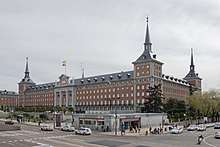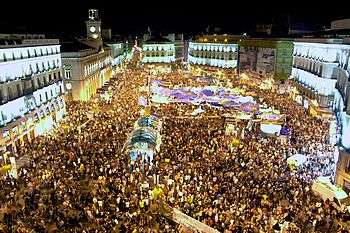History of Madrid
The documented history of Madrid dates to the 9th century, even though the area has been inhabited since the Stone Age. The development of Madrid as administrative centre began when Philip II set his court there in the 1560s. Madrid has been the country's capital continuously since 1606.
History of name
There are several theories regarding the origin of the name "Madrid". According to legend, Madrid was founded by Ocno Bianor (son of King Tyrrhenius of Tuscany and Mantua) and was named "Metragirta" or "Mantua Carpetana". Others contend that the original name of the city was "Ursaria" ("land of bears" in Latin), because of the many bears that were to be found in the nearby forests, which, together with the strawberry tree (Spanish madroño), have been the emblem of the city from the Middle Ages.[1]
The most ancient recorded name of the city "Magerit" (for *Materit or *Mageterit?) comes from the name of a fortress built on the Manzanares River in the 9th century AD, and means "Place of abundant water."[2] If the form is correct, it could be a Celtic place-name from ritu- 'ford' (Old Welsh rit, Welsh rhyd, Old Breton rit, Old Northern French roy) and a first element, that is not clearly identified *mageto derivation of magos 'field, plain' (Old Irish mag 'field', Breton ma 'place'), or matu 'bear', that could explain the Latin translation Ursalia.[3]
Nevertheless, it is now commonly believed that the origin of the current name of the city comes from the 2nd century BC. The Roman Empire established a settlement on the banks of the Manzanares river. The name of this first village was "Matrice" (a reference to the river that crossed the settlement). Following the invasions carried out by the Germanic Sueves and Vandals, as well as the Sarmatic Alans during the 5th century AD, the Roman Empire no longer had the military presence required to defend its territories on the Iberian Peninsula.[4]
As a consequence, these territories were soon occupied by the Vandals, who were in turn dispelled by the Visigoths, who then ruled Hispania in the name of the Roman emperor, also taking control of "Matrice". In the 8th century, the Umayyad conquest of the Iberian Peninsula saw the name changed to "Mayrit", from the Arabic term ميرا Mayra (referencing water as a 'tree' or 'giver of life') and the Ibero-Roman suffix it that means 'place'. The modern "Madrid" evolved from the Mozarabic "Matrit."
Early history
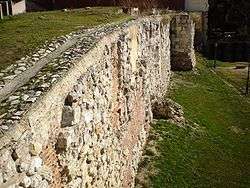
The site of modern-day Madrid has been controlled since prehistoric times, and archaeological research found a small Visigothic village nearby.[5]
In the mid-9th century, Muhammad I of Córdoba constructed a small castle where the Palacio Real stands today. The Moors built a citadel, al-Mudayna, around this castle. They named the area after the nearby Manzanares River, which the Muslims called al-Majrīṭ (Arabic: المجريط "source of water"). From this came the name Majerit or Magerit [6] in Spanish, later spelled Madrid.
The place is mentioned in the work of the 10th-century Cordobese chronicler Ahmad ibn Muhammad al-Razi, with the later locating the Castle of Madrid within the district of Guadalajara.[7] After the Christian conquest, in the first half of the 12th century Al-Idrisi described Madrid as "small city and solid fortress, well populated. In the age of Islam, it had a small mosque where the khuṭbah was always delivered," and placed it in the province of the sierra, "al-Sārrāt".[8] It was ascribed by most post-Christian conquest Muslim commentators, including Ibn Sa'id al-Maghribi, to Toledo.[9] This may tentatively suggest that the settlement, part of the cora of Guadalajara according to al-Razi, could have been transferred to Toledo following the Fitna of al-Andalus.[10]
The Moors controlled the citadel until Alfonso VI of León and Castile conquered them in 1085 in his advance towards Toledo. He reconsecrated the mosque as the church of the Virgin of Almudena (almudin, the garrison's granary).
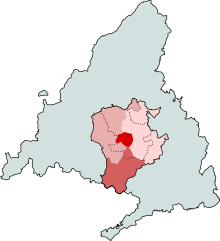
Since the mid-13th century and up to the late 14th century, the concejo of Madrid vied for the control of the Real de Manzanares territory against the concejo of Segovia, a powerful town north of the Sierra de Guadarrama mountain range, characterised by its repopulating prowess and its husbandry-based economy, contrasted by the agricultural and less competent in repopulation town of Madrid.[12] After the decline of Sepúlveda, another concejo north of the mountain range, Segovia had become a major actor south of the Guadarrama mountains, expanding across the Lozoya and Manzanares rivers to the north of Madrid and along the Guadarrama river course to its west.[12]
In 1329 Ferdinand IV of Castile first assembled the Cortes, a precursor to the modern Spanish parliament. Although it was ruled by Christian kings, many Sephardic Jews and Moors lived in Madrid until they were expelled at the end of the 15th century.
In 1383, Leo VI of Armenia was named Lord of Madrid by King John I of Castile.[13] John had previously ransomed Leo from Egyptian Mamluks, offering precious stones, silks and birds of prey for Leo's release. When Leo arrived in Medina del Campo, he was sick and poor. John granted him the town of Madrid for life, Villa Real and Andújar and a yearly gift of 150,000 maravedis. He rebuilt the towers of the alcázar. Leo ruled for only a few years.
Later, Henry III of Castile (1379–1406) rebuilt the city after it was destroyed by fire, and he founded El Pardo just outside its walls.

During the 15th century, the city became one of the preferred locations of the monarchs of the Trastámara dynasty, namely John II of Castile and Henry IV of Castile (Madrid was the town in which the latter spent more time and eventually died).[14] Among the appeals the town offered, aside from the abundant game in the surroundings, the strategic location and the closed link between the existing religious sites and the monarchy, the imposing alcázar frequently provided a safe for the Royal Treasure.[14] Madrid would also become a frequent seat of the court during the reign of the Catholic Monarchs, spending reportedly more than 1000 days in the city, including a 8-month long uninterrupted spell.[14]
The Kingdoms of Castile and Aragón became further united during the rule of Charles.
The 1520–21 Revolt of the Comuneros succeeded in the city, as, following contacts with the neighbouring city of Toledo,[15] the comunero rebels deposed the corregidor, named Antonio de Astudillo, by 17 June 1520.[16] Juan Zapata and Pedro de Montemayor found themselves among the most uncompromising supporters of the comunero cause in Madrid, with the former becoming the captain of the local militias while the later was captured by royalists and executed by late 1520.[17] The end of revolt came through a negotiation, though, and another two of the leading figures of the uprising (the Bachelor Castillo and Juan Negrete) went unpunished.[18]
Becoming capital of Spain
Philip II (1527–1598), moved the court to Madrid in 1561. Although he made no official declaration, the seat of the court became the de facto capital. Unlikely to have more than 20,000 inhabitants by the time, the city grew approaching the 100,000 mark by the end of the 16th century.[19] The population plummeted (reportedly reduced to a half) during the 5-year period the capital was set in Valladolid (1601–1606), with estimations of roughly 50–60,000 people leaving the city.[20] The move (often framed in modern usage as a case of real estate speculation) was promoted by the valido of Philip III, Duke of Lerma, who had previously acquired many properties in Valladolid.[21] Madrid undertook a mammoth cultural and economic crisis and the decimation of the price of housing ensued.[21] Lerma acquired then cheap real estate in Madrid, and suggested the King to move back the capital to Madrid.[21] The King finally accepted the additional 250,000 ducats offered by the town of Madrid in order to help financing the move of the Royal Court back to Madrid.[22]
During the 17th century, Madrid grew rapidly. The royal court attracted many of Spain's leading artists and writers to Madrid, including Cervantes, Lope de Vega, and Velázquez during the so-called cultural Siglo de Oro.
In 1739 Philip V began constructing new palaces, including the Palacio Real de Madrid. Under Charles III (1716–1788) that Madrid became a truly modern city. Charles III, who cleaned up the city and its government, became one of the most popular kings to rule Madrid, and the saying "the best mayor, the king" became widespread. Besides completing the Palacio Real, Charles III is responsible for many of Madrid's finest buildings and monuments, including the Prado and the Puerta de Alcalá.
War of independence
On 27 October 1807, Charles IV and Napoleon signed the Treaty of Fontainebleau, which allowed French troops passage through Spanish territory to join Spanish troops and invade Portugal, which had refused to obey the order for an international blockade against England. In February 1808, Napoleon used the excuse that the blockade against England was not being respected at Portuguese ports to send a powerful army under his brother-in-law, General Joachim Murat. Contrary to the treaty, French troops entered via Catalonia, occupying the plazas along the way. Thus, throughout February and March 1808, cities like Barcelona and Pamplona remained under French rule.
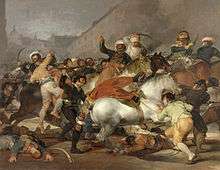
While all this was happening, the Mutiny of Aranjuez (17 March 1808) took place, led by Charles IV's own son, crown prince Ferdinand, and directed against him. Charles IV resigned and Ferdinand took his place as King Ferdinand VII. In May 1808, Napoleon's troops entered the city. On 2 May 1808 (Spanish: Dos de Mayo), the Madrileños revolted against the French forces, whose brutal behavior would have a lasting impact on French rule in Spain and France's image in Europe in general. Thus, Ferdinand VII returned to a city that had been occupied by Murat.[23]
Both the king and his father became virtual prisoners of the French army. Napoleon, taking advantage of the weakness of the Bourbons, forced both, first the father and then the son, to meet him at Bayonne, where Ferdinand VII arrived on 20 April. Here Napoleon forced both kings to abdicate on 5 May, handing the throne to his brother Joseph Bonaparte.
On 2 May, the crowd began to concentrate at the Palacio Real and watched as the French soldiers removed the royal family members from the palace. On seeing the infante Francisco de Paula struggling with his captor, the crowd launched an assault on the carriages, shouting ¡Que se lo llevan! (They're taking him away from us!). French soldiers fired into the crowd. The fighting lasted for hours and is reflected in Goya's painting, The Second of May 1808, also known as The Charge of the Mamelukes.
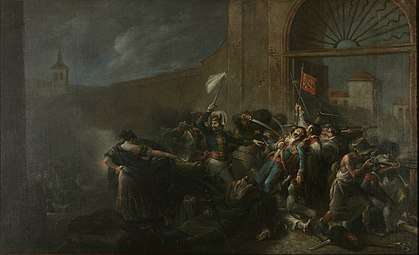
Meanwhile, the Spanish military remained garrisoned and passive. Only the artillery barracks at Monteleón under Captain Luis Daoíz y Torres, manned by four officers, three NCOs and ten men, resisted. They were later reinforced by a further 33 men and two officers led by Pedro Velarde y Santillán, and distributed weapons to the civilian population.[24] After repelling a first attack under French General Lefranc, both Spanish commanders died fighting heroically against reinforcements sent by Murat. Gradually, the pockets of resistance fell. Hundreds of Spanish men and women and French soldiers were killed in this skirmish.
On 12 August 1812, following the defeat of the French forces at Salamanca, English and Portuguese troops entered Madrid and surrounded the fortified area occupied by the French in the district of Retiro. Following two days of Siege warfare, the 1,700 French surrendered and a large store of arms, 20,000 muskets and 180 cannon, together with many other supplies were captured, along with two French Imperial Eagles.[25]
On 29 October, Hill received Wellington's positive order to abandon Madrid and march to join him. After a clash with Soult's advance guard at Perales de Tajuña on the 30th, Hill broke contact and withdrew in the direction of Alba de Tormes.[26] Joseph re-entered his capital on 2 November.
Fernandine Madrid (1814–1833)
Antonio Alcalá Galiano. Recuerdos de un anciano.
After the war of independence Ferdinand VII returned to the throne (1814). The projects of reform by Joseph Bonaparte were abandoned; during the Fernandine period, despite the proposal of several architectural projects for the city, the lack of ability to finance those led to works often being postponed or halted.
After a liberal military revolution, Colonel Riego made the king swear to respect the Constitution. Liberal and conservative government thereafter alternated, ending with the enthronement of Isabella II.
Reign of Isabella II (1833–1868)
By the time the reign of Isabella II started, the city was still enclosed behind its walls, featuring a relatively slow demographic growth as well as very high population density. After the 1833 administrative reforms for the country devised by Javier de Burgos (including the configuration of the current province of Madrid), Madrid was to become the capital of the new Liberal state.
The reforms enacted by Finance Minister Juan Álvarez Mendizábal in 1835–1836 led to the confiscation of ecclesiastical properties and the subsequent demolition of churches, convents and adjacent orchards in the city (similarly to other Spanish cities); the widening of streets and squares ensued.
In 1854, amid economic and political crisis, following the pronunciamiento of group of high officers commanded by Leopoldo O'Donnell garrisoned in the nearby town of Vicálvaro in June 1854 (the so-called "Vicalvarada"), the 7 July Manifesto of Manzanares, calling for popular rebellion,[31] and the ousting of Luis José Sartorius from the premiership on 17 July,[32] popular mutiny broke out in Madrid, asking for a real change of system,[33] in what it was to be known as the Revolution of 1854. With the uprising in Madrid reaching its pinnacle on 17, 18 and 19 July,[34] the insurrects, who erected barricades in the streets, were bluntly crushed by the new government.[35]
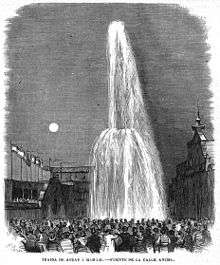
1858 was a marked year for the city with the arrival of the waters from the Lozoya. The Canal de Isabel II was inaugurated on 24 June 1858.[36] A ceremony took place soon after in Calle Ancha de San Bernardo to celebrate it, unveiling a 30-metre high water source in the middle of the street.[37][n. 2]
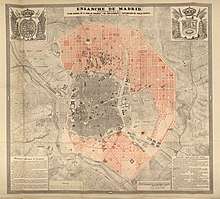
The plan for the Ensanche de Madrid ('widening of Madrid') by Carlos María de Castro was passed through a Royal Decree issued on 19 July 1860.[38] The plan for urban expansion by Castro, a staunch Conservative,[38] delivered a segregation of the well-off class, the middle class and the artisanate into different zones.[39]
Student unrest took place in 1865 following the ministerial decree against the expression of ideas against the monarchy and the Church and the forced removal of the rector of the Universidad Central, unwilling to submit. In a crescendo of protests, the night of 10 April 2,000 protesters clashed against the Civil Guard. The unrest was crudely quashed, leaving 14 deaths, 74 wounded students and 114 arrests (in what became known as the "Night of Saint Daniel"), becoming the precursor of more serious revolutionary attempts.[40]
The Sexenio Democrático (1868–1874)

The Glorious Revolution resulting in the deposition of Queen Isabella II started with a pronunciamiento in the bay of Cádiz in September 1868.[41] The success of the uprising in Madrid on 29 September prompted the French exile of the Queen, who was on holiday in San Sebastián and was unable to reach the capital by train.[42] General Juan Prim, the leader of the liberal progressives, was received by the Madrilenian people at his arrival to the city in early October in a festive mood. He pronounced his famous speech of the "three nevers" directed against the Bourbons,[43] and delivered a highly symbolical hug to General Serrano, leader of the revolutionary forces triumphant in the 28 September battle of Alcolea, in the Puerta del Sol.[44]
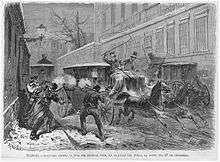
On 27 December 1870 the car in which General Prim, the prime minister, was travelling, was shot by unknown hit-men in the Turk Street, nearby the Congress of Deputies. Prim, wounded in the attack, died three days later, with the elected monarch Amadeus, Duke of Aosta, yet to swear the constitution.
The creation of the Salamanca–Sol–Pozas tram service in Madrid in 1871 meant the introduction of the first collective system of transportation in the city, predating the omnibus.[45]
Restoration (1874–1931)
The late 19th century saw the introduction of the electric power distribution. As by Law, the city council could not concede an industrial monopoly to any company, the city experienced a huge competition among the companies in the electricity sector.[46] The absence of a monopoly led to an overlapping of distribution networks, to the point that in the centre of Madrid 5 different networks could travel through the same street.[47]
By the end of the 19th century the city featured access to water, a central status in the rail network, a cheap workforce and access to financial capital.[48] With the onset of the new century, the Ensanche Sur (in the current day district of Arganzuela) started to grow to become the main industrial area of the municipality along the first half of the 20th century.[49]
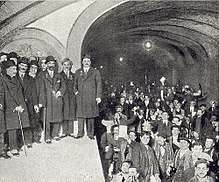
In the early 20th century Madrid undertook a major urban intervention in its city centre with the creation of the Gran Vía, a monumental thoroughfare (then divided in three segments with different names) whose construction slit the city from top to bottom with the demolition of multitude of housing and small streets.[50] Anticipated in earlier projects, and following the signature of the contract, the works formally started in April 1910 with a ceremony led by King Alfonso XIII.[50]
Also with the turn of the century, Madrid had become the cultural capital of Spain as centre of top knowledge institutions (the Central University, the Royal Academies, the Institución Libre de Enseñanza or the Ateneo de Madrid), also concentrating the most publishing houses and big daily newspapers, amounting for the bulk of the intellectual production in the country.[51]
In 1919 the Madrid Metro (known as the Ferrocarril Metropolitano by that time) inaugurated its first service, which went from Sol to the Cuatro Caminos area.[52]
In the 1919–1920 biennium Madrid witnessed the biggest wave of protests seen in the city up to that date, being the centre of innumerable strikes; despite being still surpassed by Barcelona's, the industrial city par excellence in that time, this cycle decisively set the foundations for the social unrest that took place in the 1930s in the city.[53]
The situation the Monarchy had left Madrid in 1931 was catastrophic, with tens of thousands of kids receiving no education and a huge rate of unemployment.[54]
Second Republic
After the proclamation of the Second Republic on 14 April 1931 the citizens of Madrid understood the free access to the Casa de Campo (until then an enclosed property with exclusive access for the Royalty), was a consequence of the Fall of the Monarchy, and informally occupied the area on 15 April.[55] After the signing of a decree on 20 April which granted the area to the Madrilenian citizens in order to become a "park for recreation and instruction", the transfer was formally sealed on 6 May when Minister Indalecio Prieto formally delivered the Casa de Campo to the Mayor Pedro Rico.[56] The Spanish Constitution of 1931 was the first legislating on the state capital, setting it explicitly in Madrid. During the 1930s, Madrid enjoyed "great vitality"; it was demographically young, but also young in the sense of its relation with the modernity.[57] During this time the prolongation of the Paseo de la Castellana towards the North was projected.[58] The proclamation of the Republic slowed down the building of new housing.[59] The tertiary sector gave thrust to the economy.[60] Illiteracy rates were down to below 20 %, and the city's cultural life grew notably during the so-called Silver Age of Spanish Culture; the sales of newspaper also increased.[61] Anti-clericalism and Catholicism lived side by side in Madrid; the burning of convents initiated after riots in the city in May 1931 worsened the political environment.[62] The 1934 insurrection largely failed in Madrid.[63]
In order to deal with the unemployment the new Republican city council hired many jobless people as gardeners and street cleaners.[54]
Prieto, who sought to turn the city into the "Great Madrid", capital of the Republic, charged Secundino Zuazo with the project for the opening of a south–north axis in the city through the northward enlargement of the Paseo de la Castellana and the construction of the Nuevos Ministerios administrative complex in the area[64] (halted by the Civil War, works in the Nuevos Ministerios would finish in 1942). Works on the Ciudad Universitaria, already started during the monarchy in 1929, also resumed.[65]
Civil War (1936–1939)
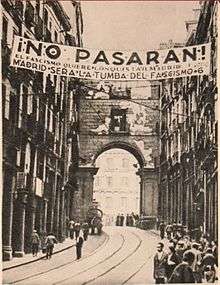
- Botched coup
The military uprising of July 1936 was defeated in Madrid by a combination of loyal forces and workers' militias. On 20 July armed workers and loyal troops stormed the single focus of resistance, the Cuartel de La Montaña, defended by a contingent of 2,000 rebel soldiers accompanied by 500 falangists under the command of General Fanjul, killing over one hundred of rebels after their surrender.[67] Aside from the Cuartel de la Montaña episode, the wider scheme for the coup in the capital largely failed both due to disastrous rebel planning and due to the Government delivering weapons to the people wanting to defend the Republic,[68] with the city becoming a symbol of popular resistance, "the people in arms".[67]
- Siege
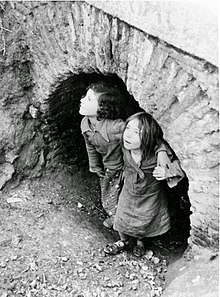
After the quelling of the coup d'état, from 1936–1939, Madrid was held by forces loyal to the Spanish Republic. Following the seemingly unstopable advance towards Madrid of rebel land troops, the first air bombings on Madrid also started.[69] Immediately after the bombing of the nearing airports of Getafe and Cuatro Vientos, Madrid proper was bombed for the first time in the night of the 27–28 August 1936 by a Luftwaffe's Junkers Ju 52 that threw several bombs on the Ministry of War and the Station of the North. Madrid "was to become the first big european city to be bombed by aviation".[70]
Rebel General Francisco Franco, recently given the supreme military command over his faction, took a detour in late September to "liberate" the besieged Alcázar de Toledo. Meanwhile, this operation gave time to the republicans in Madrid to build defenses and start receiving some foreign support.[69]
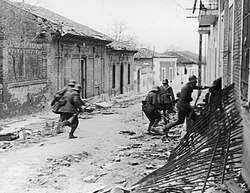
The Summer and Autumn of 1936 saw the Republican Madrid witness of heavy-hand repression by Communist and Socialist groups, symbolised by the murder of prisoners in checas and sacas directed mostly against military personnel and leading politicians linked to the rebels, which, culminated by the horrific Paracuellos massacres in the context of a simultaneous major rebel offensive against the city, were halted by early December.[71] Madrid, besieged from October 1936, saw a major offensive in its western suburbs in November of that year.
- Collapse
In the last weeks of the war the collapse of the republic was speeded by Colonel Segismundo Casado, who, endorsed by some political figures such as Anarchist Cipriano Mera and Julián Besteiro, a PSOE leader who had held talks with the Falangist fifth column in the city, threw a military coup against the legitimate government under the pretext of excessive communist preponderance, propelling a mini-civil war in Madrid that, won by the casadistas, left roughly 2,000 casualties between 5–10 March 1939.[72]
The city fell to the nationalists on 28 March 1939.
Francoist dictatorship (1939–1975)
Following the onset of the Francoist dictatorship in the city, the absence of personal and associative freedoms and the heavy-hand repression of people linked to a republican past greatly deprived the city from social mobilization, trade unionism and intellectual life.[73] This added to a climate of general shortage, with ration coupons rampant and a lingering autarchic economy lasting until the mid 1950s.[73]
With the country ruined after the war, the Falange command had nonetheless high plans for the city and professionals sympathetic to the regime dreamed (based on an organicist conception) about the notion of building a body for the "Spanish Greatness" placing a great emphasis in Madrid, what they thought to be the imperial capital of the New State.[74] In this sense, urban planners sought to highlight and symbolically put in value the façade the city offered to the Manzanares River,[75] the "Imperial Cornice", bringing projects to accompany the Royal Palace such as the finishing of the unfinished cathedral (with the start of works postponed to 1950 and ultimately finished in the late 20th century), a never built "house of the Party" and many others.[76] Nonetheless these delusions of grandeur caught up with reality and the scarcity during the Post-War and most of the projects ended up either filed, unfinished or mutilated, with the single clear success being the Gutiérrez Soto's Cuartel del Ejército del Aire.[77]
During the dictatorship, especially after the sixties, the south of Madrid became very industrialized and experienced massive migrations from rural environments into the city. Madrid's south-eastern periphery became an extensive slum settlement, which was the base for an active cultural and political life.

In the 1948–1954 period the municipality greatly increased in size through the annexation of 13 surrounding municipalities, as its total area went up from 68,42 km2 to 607,09 km2. The annexed municipalities were Chamartín de la Rosa (5 June 1948), Carabanchel Alto (29 April 1948), Carabanchel Bajo (29 April 1948), Canillas (30 March 1950), Canillejas (30 March 1950), Hortaleza (31 March 1950), Barajas (31 March 1950), Vallecas (22 December 1950), El Pardo (27 March 1951), Vicálvaro (20 October 1951), Fuencarral (20 October 1951) Aravaca (20 October 1951) and Villaverde (31 July 1954).[78]
The population of the city peaked in 1975 at 3,228,057 inhabitants.[79]
Contemporary Madrid
Benefiting from prosperity in the 1980s, Spain's capital city has consolidated its position as the leading economic, cultural, industrial, educational and technological center of the Iberian peninsula. The relative decline in population since 1975 reverted in the 1990s, with the city recovering a population of roughly 3 million inhabitants by the end of the 20th century.[79]
Since the late 1970s and through the 1980s Madrid became the center of the cultural movement known as la Movida. Conversely, just like in the rest of the country, an heroin crisis took a toll in the poor neighborhoods of Madrid in the 1980s.[80]
During the mandate as Mayor of José María Álvarez del Manzano construction of traffic tunnels below the city proliferated.[81]
On 11 March 2004, three days before Spain's general elections and exactly 2 years and 6 months after the September 11 attacks in the US, Madrid was hit by a terrorist attack when Islamic terrorists belonging to an al-Qaeda-inspired terrorist cell[82] placed a series of bombs on several trains during the morning rush hour, killing 191 people and injuring 1,800.
The administrations that followed Álvarez del Manzano's, also conservative, led by Alberto Ruiz-Gallardón and Ana Botella, launched three unsuccessful bids for the 2012, 2016 and 2020 Summer Olympics.[83] Madrid was a centre of the anti-austerity protests that erupted in Spain in 2011. As consequence of the spillover of the 2008 financial and mortgage crisis, Madrid has been affected by the increasing number of second-hand homes held by banks and house evictions.[84] The mandate of left-wing Mayor Manuela Carmena (2015–2019) delivered the renaturalization of the course of the Manzanares across the city.
Since the late 2010s, the challenges the city faces include the increasingly unaffordable rental prices (often in parallel with the gentrification and the spike of tourist apartments in the city centre) and the profusion of betting shops in working-class areas, equalled to an "epidemics" among the young people.[85][86]
Population
| Year | Population[87] | |
|---|---|---|
| 1530 | 4000–5,500 | |
| 1600 | 30,000 | |
| 1700 | 110,000 | |
| 1800 | 160,000 | |
| 1850 | 281,000 | |
| 1872 | 333,745 | |
| 1880 | 398,000 | |
| 1900 | 539,835 | |
| 1910 | 599,000 | |
| 1930 | 952,000 | |
| 1959 | 2,000,000 | |
| 1968 | 3,000,000 | |
| 1975 | 3,228,057 | |
See also
References
- Informational notes
- This and other sixteenth and seventeenth century views of Madrid (from Frederic de Witt and Pedro Texeira) can be seen at this website Archived 15 August 2011 at the Wayback Machine
- The following hymn was sung during the ceremony: Honor, glory to the Science, irresistible lever to the creator genius. Thanks to it, the fiery Lozoya uproots from its seat and elevates towards the firmament its immense water dispenser ("Honor, gloria a la Ciencia, palanca irresistible al genio creador. Por él Lozoya altivo se arranca de su asiento y eleva al firmamento su inmenso surtidor").[37]
- Citations
- "El Madrid Medieval (Medieval Madrid). Includes Pre-historic, Roman and medieval up to the Catholic Monarchs". History of Madrid. (in Spanish). José Manuel Castellanos. Retrieved 28 October 2007.
- "Madrid History – Museums – Suggested Itineraries Madrid". Indigoguide.com. Archived from the original on 1 January 2011. Retrieved 3 February 2010.
- Xavier Delamarre, Dictionnaire de la langue gauloise, éditions errance 2003. p. 258.
- "El Madrid Medieval (Medieval Madrid). Includes Pre-historic, roman and medieval up to the Catholic Monarchs times.". History of Madrid. (in Spanish). José Manuel Castellanos. Retrieved 28 October 2007.
- https://theculturetrip.com/europe/spain/articles/the-story-of-how-madrid-got-its-name/
- Mazzoli-Guintard & Viguera Molins 2017, p. 106.
- Mazzoli-Guintard & Viguera Molins 2017, p. 107.
- María Jesús Viguera Molins 2017, pp. 102, 108.
- Mazzoli-Guintard & Viguera Molins 2017, p. 108.
- Bahamonde Magro & Otero Carvajal 1989, p. 13.
- Bahamonde Magro & Otero Carvajal 1989, pp. 11–12.
- Un Madrid insólito: Guía para dejarse sorprender, pg. 39–40. Jesús Callejo. Editorial Complutense, 2001. ISBN 84-7491-630-5. The book, however, talks about Leon V of Armenia.
- Rábade Obradó 2009.
- Diago Hernando 2005, p. 36.
- Diago Hernando 2005, p. 41–42.
- Diago Hernando 2005, p. 54–57.
- Diago Hernando 2005, p. 92.
- Carbajo Isla 1985, p. 67.
- Carbajo Isla 1985, p. 68.
- Congostrina, Nieves (31 August 2019). "Solo Madrid es corte". El País.
- Carbajo Isla 1985, p. 69.
- Chandler, David G. (1995), The Campaigns of Napoleon, Simon & Schuster, p. 610, ISBN 0-02-523660-1
- "Spain". Deutsches Historisches Museum. Retrieved 23 July 2013.
- Porter, Maj Gen Whitworth (1889). History of the Corps of Royal Engineers Vol I. Chatham: The Institution of Royal Engineers.
- Gates (2002), pp. 373-374
- Fernández Trillo 1982, p. 18.
- Zozaya 2012, p. 21.
- Zozaya 2012, p. 30.
- Fernández Trillo 1982, p. 24.
- Zozaya 2012, pp. 30–31.
- Bonet Correa 2002, p. 61.
- Bonet Correa 2002, pp. 62–63.
- Díez de Baldeón 1986, p. 121.
- Schubert 2003, p. 17.
- González Calleja 2005, pp. 26–27.
- Cañas de Pablos 2018, p. 200.
- Castro, Antonio (28 September 2018). "150 años de La Gloriosa". Madridiario.
- Cañas de Pablos 2018, p. 212.
- Cañas de Pablos 2018, pp. 212-213.
- Amann 2018, p. 1.
- Aubanell Jubany 1992, pp. 143–145.
- Aubanell Jubany 1992, pp. 145–146.
- Celada & Ríos 1989, pp. 200–201.
- Celada & Ríos 1989, p. 213.
- Díaz Villanueva, Fernando (7 April 1910). "Gran Vía: la calle que nunca debió ser". Libertad Digital.
- Otero Carvajal 2016, p. 266.
- Cordero de Ciria & Arribas Álvarez 1989, p. 388.
- Sánchez Pérez 2008, p. 546.
- Esteban Gonzalo 2009, pp. 125–126.
- Pérez-Soba Díez del Corral 1997, p. 429.
- Pérez-Soba Díez del Corral 1997, pp. 429; 431.
- Montero & Cervera Gil 2009, p. 15.
- Montero & Cervera Gil 2009, p. 16.
- Montero & Cervera Gil 2009, p. 17.
- Montero & Cervera Gil 2009, p. 20.
- Montero & Cervera Gil 2009, p. 21.
- Montero & Cervera Gil 2009, p. 25; 26.
- Montero & Cervera Gil 2009, p. 26.
- Otero Carvajal 2016, pp. 261–262.
- Otero Carvajal 2016, p. 262.
- Ruiz 2005, p. 10.
- Casanova 2010, p. 154.
- Rodríguez Lozano 2015, p. 108.
- Gorostiza Langa & Saurí Pujol 2013.
- Solé i Sabaté y Villarroya 2003, pp. 45–46.
- Casanova 2010, pp. 197–198.
- Casanova 2010, pp. 273–274.
- Sánchez Pérez 2008, p. 556.
- Box 2012, pp. 151–154.
- Box 2012, pp. 166–167.
- Box 2012, pp. 175–176.
- Box 2012, pp. 170–172.
- García Alvarado & Alcolea Moratilla 2005, p. 414.
- Brandis García 2008, p. 519.
- Carretero, Nacho (October 2018). "Quinquis: un vistazo rápido a las barriadas españolas de los 80". Jot Down.
- "Obras, túneles y casticismo". El Mundo. Retrieved 6 February 2020.
- "Madrid bombers 'were inspired by Bin Laden address'" Archived 6 July 2008 at the Wayback Machine The Independent. Retrieved 23 July 2013.
- Llamas, Manuel (9 September 2013). "El sueño olímpico costó 2.000 euros a cada contribuyente madrileño". Libre Mercado (in Spanish). Retrieved 6 February 2020.
- Jiménez Barrado, Víctor; Sánchez Martín, José Manuel (2016). "Banca privada y vivienda usada en la ciudad de Madrid" (PDF). Investigaciones Geográficas (66): 43–58. doi:10.14198/INGEO2016.66.03. ISSN 0213-4691.
- "Una casa de apuestas cada 100 metros: el juego se ceba en barrios pobres de Madrid". El Español (in Spanish). 2 January 2019. Retrieved 6 February 2020.
- Aunión, J.A.; Clemente, Yolanda (26 February 2018). "How tourist apartments are hurting Madrid's neighborhoods". El País.
- Ladero Quesada 2013, p. 191; Juliá 1989, p. 139; Brandis García 2008, p. 519; Izquierdo 1973, pp. 14–15; Fernández García 1989, p. 34
- Bibliography
- Amann, Elizabeth (2018). "En tranvía: Nineteenth-Century Representations of Collective Transportation in Madrid". Bulletin of Spanish Studies: 1–16. doi:10.1080/14753820.2018.1538038.CS1 maint: ref=harv (link)
- Aubanell Jubany, Anna Maria (1992). "La competencia en la distribución de electricidad en Madrid, 1890-1913". Revista de Historia Industrial. Barcelona: Universitat de Barcelona (2). ISSN 1132-7200.CS1 maint: ref=harv (link)
- Bahamonde Magro, Ángel; Otero Carvajal, Luis Enrique (1989). Madrid, de territorio fronterizo a región metropolitana (PDF). Madrid: Espasa Calpe.CS1 maint: ref=harv (link)
- Bonet Correa, Antonio (2002). "Madrid y el Canal de Isabel II". Arbor. Madrid: Consejo Superior de Investigaciones Científicas. 171 (673). doi:10.3989/arbor.2002.i673.1021. ISSN 0210-1963.CS1 maint: ref=harv (link)
- Box, Zira (2012). "El cuerpo de la nación. Arquitectura, urbanismo y capitalidad en el primer franquismo". Revista de Estudios Políticos. Madrid: Centro de Estudios Políticos y Constitucionales. ISSN 0048-7694.CS1 maint: ref=harv (link)
- Brandis García, Dolores (2008). "La expansión de la ciudad en el siglo XX". Madrid, de la Prehistoria a la Comunidad Autónoma (PDF). Madrid: Consejería de Educación de la Comunidad de Madrid. pp. 519–539. ISBN 978-84-451-3139-8.CS1 maint: ref=harv (link)
- Cañas de Pablos, Alberto (2018). "La revolución de puerto en puerto hacia la capital: la vertiente marítima de la "Gloriosa" y la llegada de Prim a Madrid". Cuadernos de Historia Contemporánea. Madrid: Ediciones Complutense. 40: 199–218. doi:10.5209/CHCO.60329. ISSN 0214-400X.CS1 maint: ref=harv (link)
- Carbajo Isla, María F. (1985). "La inmigración a Madrid (1600-1850)" (PDF). Reis. Madrid: Centro de Investigaciones Sociológicas (32): 67–100. ISSN 0210-5233.CS1 maint: ref=harv (link)
- Casanova, Julián (2010) [2007]. The Spanish Republic and Civil War. (translated by Martin Douch). Cambridge University Press. ISBN 978-0-511-78963-2.CS1 maint: ref=harv (link)
- Celada, Francisco; Ríos, Josefa (1989). "Localización espacial de la industria madrileña en 1900". In Ángel Bahamonde Magro; Luis Enrique Otero Carvajal (eds.). La sociedad madrileña durante la Restauración 1876-1931 (PDF). I. Madrid: Consejería de Cultura de la Comunidad de Madrid. pp. 199–214. ISBN 84-86635-09-8. Archived from the original (PDF) on 19 February 2019.CS1 maint: ref=harv (link)
- Cordero de Ciria, José E.; Arribas Álvarez, José Fco. (1989). "Transporte y estructura metropolitana en el Madrid de la Restauración. Historia de una frustración". In Ángel Bahamonde Magro; Luis Enrique Otero Carvajal (eds.). La sociedad madrileña durante la Restauración 1876-1931 (PDF). I. Madrid: Consejería de Cultura de la Comunidad de Madrid. pp. 377–399. ISBN 84-86635-09-8. Archived from the original (PDF) on 19 February 2019.CS1 maint: ref=harv (link)
- Diago Hernando, Máximo (2005). "Realistas y comuneros en Madrid en los años 1520 y 1521. Introducción al estudio de su perfil sociopolítico" (PDF). Anales del Instituto de Estudios Madrileños. XLV: 35–93. ISSN 0584-6374.CS1 maint: ref=harv (link)
- Díez de Baldeón, Clementina (1986). "Barrios obreros en el Madrid del siglo XIX: ¿Solución o amenaza para el orden burgués?". Madrid en la sociedad del siglo XIX (PDF). I. Madrid: Consejería de Cultura de la Comunidad de Madrid. pp. 117–134. ISBN 84-86635-01-2. Archived from the original (PDF) on 20 February 2019.CS1 maint: ref=harv (link)
- Esteban Gonzalo, José (2009). "El Madrid de la República". La República y la cultura: paz, guerra y exilio. Madrid: Ediciones Akal. pp. 125–132.CS1 maint: ref=harv (link)
- Fernández García, Antonio (1989). "La población madrileña entre 1876 y 1931. El cambio de modelo demográfico". In Ángel Bahamonde Magro; Luis Enrique Otero Carvajal (eds.). La sociedad madrileña durante la Restauración 1876-1931 (PDF). I. Madrid: Consejería de Cultura de la Comunidad de Madrid. pp. 29–76. ISBN 84-86635-09-8. Archived from the original (PDF) on 19 February 2019.CS1 maint: ref=harv (link)
- Fernández Trillo, Manuel (1982). "La Vicalvarada y la Revolución Española de 1854" (PDF). Tiempo de Historia. VIII (87): 16–29.
- García Alvarado, José María; Alcolea Moratilla, Miguel Ángel (2005). "Cambios municipales en la Comunidad de Madrid (1900-2003)" (pdf). Anales de Geografía de la Universidad Complutense. Madrid: Servicio de publicaciones de la Universidad Complutense de Madrid. 25: 307–330. ISSN 1988-2378.CS1 maint: ref=harv (link)
- González Calleja, Eduardo (2005). "Rebelión en las aulas: un siglo de movilizaciones estudiantiles en España (1865-1968)". Ayer. Madrid: Asociación de Historia Contemporánea & Marcial Pons Ediciones de Historia (59). ISSN 1134-2277. JSTOR 41325126.CS1 maint: ref=harv (link)
- Gorostiza Langa, Santiago; Saurí Pujol, David (2013). "Salvaguardar un recurso precioso: la gestión del agua en Madrid durante la guerra civil española (1936-1939)". Scripta Nova. Barcelona: Universitat de Barcelona. 17 (457). ISSN 1138-9788.CS1 maint: ref=harv (link)
- Izquierdo, Antonio (1973). "Del marqués de Aguilar de Campoo a Miguel Ángel García Lomas" (PDF). Villa de Madrid. Madrid: Ayuntamiento de Madrid. X (40): 6–15. ISSN 0042-6164.CS1 maint: ref=harv (link)
- Juliá, Santos (1989). "De poblachón mal construido a esbozo de gran capital: Madrid en el umbral de los años treinta". In Ángel Bahamonde Magro; Luis Enrique Otero Carvajal (eds.). La sociedad madrileña durante la Restauración 1876-1931 (PDF). I. Madrid: Consejería de Cultura de la Comunidad de Madrid. pp. 137–149. ISBN 84-86635-09-8. Archived from the original (PDF) on 19 February 2019.CS1 maint: ref=harv (link)
- Ladero Quesada, Miguel Ángel (2013). "Población de las ciudades en la baja Edad Media (Castilla, Aragón, Navarra)" (PDF). I Congresso Histórico Internacional. As cidades na histórica: população. 24 a 26 de outubro de 2012. ATAS. I. Câmara Municipal de Guimarães. pp. 165–201. ISBN 978-989-8474-11-7.CS1 maint: ref=harv (link)
- Mazzoli-Guintard, Christine; Viguera Molins, María Jesús (2017). "Literatura y territorio: Madrid (Maŷrīṭ) en el Mugrib de Ibn Sa´īd (s. XIII)". Philologia Hispalensis. 31 (2): 99–115. doi:10.12795/PH.2017.i31.14. ISSN 1132-0265.CS1 maint: ref=harv (link)
- Navascués Palacio, Pedro (1994). "Madrid, ciudad y arquitectura (1808-1898)". Historia de Madrid (PDF). Madrid: Editorial Complutense. pp. 401–440. ISBN 84-7491-474-4.CS1 maint: ref=harv (link)
- Montero, Julio; Cervera Gil, Javier (2009). "Madrid en los años treinta: ambiente social, político, cultural y religioso" (PDF). Studia et Documenta: rivista dell'Istituto Storico San Josemaría Escrivá (3): 13–39. ISSN 1970-4879.CS1 maint: ref=harv (link)
- Otero Carvajal, Luis Enrique (2016). "La sociedad urbana y la irrupción de la Modernidad en España, 1900-1936". Cuadernos de Historia Contemporánea. Madrid: Ediciones Complutense. 38. doi:10.5209/CHCO.53678. ISSN 0214-400X.CS1 maint: ref=harv (link)
- Pérez-Soba Díez del Corral, Ignacio (1997). "El parque de la Casa de Campo en la estructura urbana de Madrid. Evolución histórica". Estudios Geográficos. Madrid: Consejo Superior de Investigaciones Científicas. 58 (228). ISSN 0014-1496.CS1 maint: ref=harv (link)
- Rábade Obradó (2009). "Escenario para una Corte real: Madrid en tiempos de Enrique IV". e-Spania (8). doi:10.4000/e-spania.18883. ISSN 1951-6169.CS1 maint: ref=harv (link)
- Rodríguez Lozano, Iván (2015). "El pueblo en armas. Vicálvaro y el golpe de 1936" (PDF). Espiral, Estudios sobre Estado y Sociedad. 22 (64): 101–145. ISSN 1665-0565.CS1 maint: ref=harv (link)
- Ruiz, Julius (2005). Franco’s Justice. Repression in Madrid after the Spanish Civil War. Oxford University Press. ISBN 0-19-928183-1.CS1 maint: ref=harv (link)
- Solé i Sabaté, Josep Maria; Villarroya, Joan (2003). España en llamas. La guerra civil desde el aire. Madrid: Temas de Hoy. ISBN 84-8460-302-4.
- Sánchez Pérez, Francisco (2008). "Política y sociedad en el Madrid del siglo XX". Madrid, de la Prehistoria a la Comunidad Autónoma (PDF). Madrid: Consejería de Educación de la Comunidad de Madrid. pp. 541–563. ISBN 978-84-451-3139-8.CS1 maint: ref=harv (link)
- Shubert, Adrian (2003). A Social History of Modern Spain. London & New York: Routledge. ISBN 1134875533.
- Zozaya, María (2012). "'Moral Revenge of the Crowd' in the 1854 Revolution in Madrid" (PDF). Bulletin for Spanish and Portuguese Historical Studies. 37 (1): 18–46.CS1 maint: ref=harv (link)
